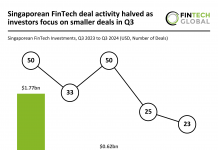As new technologies and digitalisation continue to change the way wealth managers operate, it’s more essential now than ever to understand the changing needs and requirements of clients and capitalise on client-centricity and digitally-enabled interaction channels.
Like many industries, wealth and asset management is on the cusp of digital disruption. It’s no secret that the inexorable shift to a digital marketplace has the potential to generate significant cost reductions and drive a substantial amount of gains. This will almost certainly thrust some firms into new prominence and leave others behind.
According to Nucoro head of strategy and partnerships Nikolai Hack, “The fact that we are even asking the question shows just how far behind [in digitalisation] wealth management really is.”
Echoing a similar sentiment, WealthObjects CEO and founder Uday Nimmakayala said, “Any firm serious about retaining their customers for the next three to five years needs to think about implementing digital business models to differentiate and succeed in the long term.”
Inevitably, the issue to be addressed is no longer whether the industry will go through a digital metamorphosis but how can they ensure they are not left behind. Putting it simply, Kidbrooke CEO Fredrik Daveus said, “It’s crucial, bordering on mandatory, for survival.”
While the wealth management industry is still in the early stages of digital transformation, wealth managers are increasingly rethinking the strategies and business models that define their business. The proof is in the numbers. According to a survey of 40 global asset management firms by Consultancy UK, 79% of wealth managers admitted that they are considering digital as a top or high priority area with 55% predicting that their firms’ digital spend will increase over the next year.
Challenges of failing to keep up
Clearly, with the wealth management industry facing irreversible change, companies need to act now to ensure their digital futures. Firms in front are already seeing leaps in assets under management, profitability as well as market share. Those behind would not only be paying a high financial cost in lost revenue but run the risk of falling out of the race altogether. “Many will see their customers and revenues fall in the coming years if they don’t adapt digital at the core of their business strategy,” Nimmakayala opined.
Wealth Dynamix CEO and co-founder Gary Linieres believes digital transformation is unstoppable and must be prioritised. He said, “Failure to digitise will see operational overheads demonstrably increase, whereas successful and strategic digitisation will augment service standards as clients benefit from the capacity to engage via their channel of choice.”
Alongside costs, client expectations have risen over the past few years as they expect firms to help them manage their money more efficiently. In fact, a survey by Roubini ThoughtLab of over 2,000 investors from the financial services industry indicated that clients look to manage their money in the same way they shop, communicate, and learn: using a range of digital tools, social media and mobile apps. To add on, customers seek the same experience from investment providers that they receive from tech giants such as Google, Apple and Amazon.
“As people have become accustomed to using websites and flicking intuitively between apps, they expect their providers to follow suit and provide these,” Linieres affirmed.
Furthermore, the ongoing pandemic has catalysed the digitalisation process for the sector, therefore compelling most businesses to onboard newer ways to service clients by leveraging machine learning and automation. “The pandemic forced even the most reluctant consumers to go online, so businesses that can’t accommodate have little chance of staying in the game,” Linieres said.
“This enforced digitisation has reshaped consumers’ expectations and they’ll judge brands on their capacity to deliver, regardless of the sector they’re in.”
Tellingly, digitalisation has become synonymous with customer satisfaction. Nimmakayala said, “[Today], we define digitalisation as an experience one feels when they use a firm’s service. So, in customers’ eyes, if their experience falls short of their expectations, the firm still has a long way to digitalise.”
What can wealth managers digitise?
According to Daveus, as firms rethink their digital strategies and reset their priorities, some areas to focus on are “onboarding and KYC using digital authentication and open banking aggregators.” He added that “[automating] decision-support will enable self-service journeys for advisors and give them more time to focus on the relationships and coaching of the customer.”
Inevitably, by digitising client engagement, wealth managers will have a world of data at their fingertips. “Add tools that enable behavioural and intelligence analysis to the mix, and they can chart client sentiment and even determine the priorities they must fulfil to drive optimum client and business outcomes,” Linieres said.
However, the required change leading to an exceptional client and advisor experience including digital interaction cannot be achieved by the sole implementation of a communication tool or a digital solution that only adds value to a client-centric approach.
As Nimmakayala put it, “Many in financial services are under the impression that we have got a website and an app, so we are already digital. This false comfort is the fundamental problem with some who cannot imagine what the world will look like in the next five to ten years and do not truly understand what ‘digital’ means in this day and age.”
Indeed, client-facing services are hardly the only vertical firms need to focus on when digitising as the additional burden of manual operational workflows then fall on advisors. To become a front-runner in wealth management, digital initiatives have to be a core component. “End-to-end digitisation is critical if they’re going to avoid piling a huge burden onto the front office through increased engagement via new channels which have taken precedence throughout the pandemic,” Linieres said.
He believes that automating administrative tasks such as data input frees up advisor time as well as aids operations. “If operations functions can’t keep up with increased front-office digital interaction, ironically, it’ll be the advisors and their front office peers who pay the price,” Linieres added.
The future of wealth management
Alongside established firms in the likes of Credit Suisse, Morgan Stanley and Goldman Sachs etc, the sector is witnessing a rise in tech firms capitalising on big data and artificial intelligence. With the ubiquity of tech companies in the wealth management space specialising in robo advisors and digital investment brokers, it’s unsurprising to see how the WealthTech sector is going from strength to strength.
Interestingly, the WealthTech sector witnessed a record year in 2020 in terms of investment raised, despite the coronavirus chaos. WealthTech companies raised over $9.2bn last year, a 9.6% year-on-year growth, according to FinTech Global’s research. That is up considerably from 2016 when the global WealthTech sector raised $2.8bn.
For traditional companies to stay relevant, Linieres suggested that striking a fair balance between technology and an interpersonal relationship between the advisor and client is paramount. “The firms who can master the balance between human and digital interaction so it aligns with their clients’ expectations will stand head and shoulders above the rest,” he added.
In conclusion, to play a leading role in wealth management in the future, firms must provide clients with clear added value, have well-developed digital channels and provide cost-effective and smart services. “As an industry heavy on bodies across the entire value chain, wealth managers will only be able to keep up with these developments with the help of technology,” Hack said.
Copyright © 2021 FinTech Global











